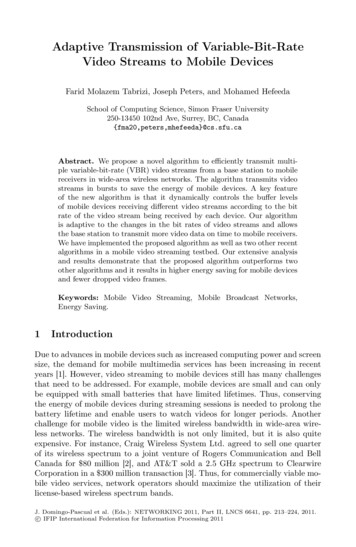
Transcription
Morbidity and Mortality Weekly ReportRecommendations and ReportsDecember 30, 2005 / Vol. 54 / No. RR-17Guidelines for Preventing the Transmissionof Mycobacterium tuberculosisin Health-Care Settings, 2005INSIDE: Continuing Education Examinationdepartment of health and human servicesdepartmentservicesCenters for Disease Control and Prevention
MMWRThe MMWR series of publications is published by theCoordinating Center for Health Information and Service,Centers for Disease Control and Prevention (CDC), U.S.Department of Health and Human Services, Atlanta, GA 30333.SUGGESTED CITATIONCenters for Disease Control and Prevention. Guidelines forPreventing the Transmission of Mycobacterium tuberculosisin Health-Care Settings, 2005. MMWR 2005;54(No. RR-17):[inclusive page numbers].Centers for Disease Control and PreventionJulie L. Gerberding, MD, MPHDirectorDixie E. Snider, MD, MPHChief Science OfficerTanja Popovic, MD, PhDAssociate Director for ScienceCoordinating Center for Health Informationand ServiceSteven L. Solomon, MDDirectorNational Center for Health MarketingJay M. Bernhardt, PhD, MPHDirectorDivision of Scientific CommunicationsMaria S. Parker(Acting) DirectorMary Lou Lindegren, MDEditor, MMWR SeriesSuzanne M. Hewitt, MPAManaging Editor, MMWR SeriesTeresa F. Rutledge(Acting) Lead Technical Writer-EditorPatricia McGeeProject EditorBeverly J. HollandLead Visual Information SpecialistLynda G. CupellMalbea A. LaPeteVisual Information SpecialistsQuang M. Doan, MBAErica R. ShaverInformation Technology SpecialistsCONTENTSIntroduction . 1Overview . 1HCWs Who Should Be Included in a TB SurveillanceProgram . 3Risk for Health-Care–Associated Transmissionof M. tuberculosis . 6Fundamentals of TB Infection Control . 6Relevance to Biologic Terrorism Preparedness . 8Recommendations for Preventing Transmissionof M. tuberculosis in Health-Care Settings . 8TB Infection-Control Program . 8TB Risk Assessment . 9Risk Classification Examples . 11Managing Patients Who Have Suspected or ConfirmedTB Disease: General Recommendations . 16Managing Patients Who Have Suspected or ConfirmedTB Disease: Considerations for Special Circumstancesand Settings . 19Training and Educating HCWs . 27TB Infection-Control Surveillance . 28Problem Evaluation . 32Collaboration with the Local or State Health Department . 36Environmental Controls . 36Respiratory Protection . 38Cough-Inducing and Aerosol-Generating Procedures . 40Supplements . 42Estimating the Infectiousness of a TB Patient . 42Diagnostic Procedures for LTBI and TB Disease . 44Treatment Procedures for LTBI and TB Disease . 53Surveillance and Detection of M. tuberculosis Infectionsin Health-Care Settings . 56Environmental Controls . 60Respiratory Protection . 75Cleaning, Disinfecting, and Sterilizing Patient-CareEquipment and Rooms . 79Frequently Asked Questions (FAQs) . 80Acknowledgments . 89References . 89Terms and Abbreviations Used in this Report . 103Glossary of Definitions . 107Appendices . 121Continuing Education Activity . CE-1Disclosure of RelationshipCDC, our planners, and our content experts wish to disclose theyhave no financial interests or other relationships with themanufacturers of commercial products, suppliers of commercialservices, or commercial supporters. Presentations will not includeany discussion of the unlabeled use of a product or a product underinvestigational use.
Vol. 54 / RR-17Recommendations and Reports1Guidelines for Preventing the Transmissionof Mycobacterium tuberculosis in Health-Care Settings, 2005Prepared byPaul A. Jensen, PhD, Lauren A. Lambert, MPH, Michael F. Iademarco, MD, Renee Ridzon, MDDivision of Tuberculosis Elimination, National Center for HIV, STD, and TB PreventionSummaryIn 1994, CDC published the Guidelines for Preventing the Transmission of Mycobacterium tuberculosis in Health-CareFacilities, 1994. The guidelines were issued in response to 1) a resurgence of tuberculosis (TB) disease that occurred in the UnitedStates in the mid-1980s and early 1990s, 2) the documentation of several high-profile health-care–associated (previously termed“nosocomial”) outbreaks related to an increase in the prevalence of TB disease and human immunodeficiency virus (HIV)coinfection, 3) lapses in infection-control practices, 4) delays in the diagnosis and treatment of persons with infectious TB disease,and 5) the appearance and transmission of multidrug-resistant (MDR) TB strains. The 1994 guidelines, which followed statements issued in 1982 and 1990, presented recommendations for TB-infection control based on a risk assessment process thatclassified health-care facilities according to categories of TB risk, with a corresponding series of administrative, environmental,and respiratory-protection control measures.The TB infection-control measures recommended by CDC in 1994 were implemented widely in health-care facilities in theUnited States. The result has been a decrease in the number of TB outbreaks in health-care settings reported to CDC and areduction in health-care–associated transmission of Mycobacterium tuberculosis to patients and health-care workers (HCWs).Concurrent with this success, mobilization of the nation’s TB-control programs succeeded in reversing the upsurge in reported casesof TB disease, and case rates have declined in the subsequent 10 years. Findings indicate that although the 2004 TB rate was thelowest recorded in the United States since national reporting began in 1953, the declines in rates for 2003 (2.3%) and 2004(3.2%) were the smallest since 1993. In addition, TB infection rates greater than the U.S. average continue to be reported incertain racial/ethnic populations. The threat of MDR TB is decreasing, and the transmission of M. tuberculosis in health-caresettings continues to decrease because of implementation of infection-control measures and reductions in community rates of TB.Given the changes in epidemiology and a request by the Advisory Council for the Elimination of Tuberculosis (ACET) forreview and update of the 1994 TB infection-control document, CDC has reassessed the TB infection-control guidelines forhealth-care settings. This report updates TB control recommendations reflecting shifts in the epidemiology of TB, advances inscientific understanding, and changes in health-care practice that have occurred in the United States during the preceding decade.In the context of diminished risk for health-care–associated transmission of M. tuberculosis, this document places emphasis onactions to maintain momentum and expertise needed to avert another TB resurgence and to eliminate the lingering threat toHCWs, which is mainly from patients or others with unsuspected and undiagnosed infectious TB disease. CDC prepared thecurrent guidelines in consultation with experts in TB, infection control, environmental control, respiratory protection, andoccupational health. The new guidelines have been expanded to address a broader concept; health-care–associated settings gobeyond the previously defined facilities. The term “health-care setting” includes many types, such as inpatient settings, outpatientsettings, TB clinics, settings in correctional facilities in which health care is delivered, settings in which home-based health-careand emergency medical services are provided, and laboratories handling clinical specimens that might contain M. tuberculosis.The term “setting” has been chosen over the term “facility,” used in the previous guidelines, to broaden the potential places forwhich these guidelines apply.IntroductionThe material in this report originated in the National Center for HIV,STD, and TB Prevention, Kevin Fenton, MD, PhD, Director; and theDivision of Tuberculosis Elimination, Kenneth G. Castro, MD, Director.Corresponding preparer: Paul A. Jensen, PhD, Division ofTuberculosis Elimination, National Center for HIV, STD, and TBPrevention, 1600 Clifton Rd., NE, MS E-10, Atlanta, GA 30333.Telephone: 404-639-8310; Fax: 404-639-8604; E-mail: pej4@cdc.gov.OverviewIn 1994, CDC published the Guidelines for Preventing theTransmission of Mycobacterium tuberculosis in Health CareFacilities, 1994 (1). The guidelines were issued in response to1) a resurgence of tuberculosis (TB) disease that occurred inthe United States in the mid-1980s and early 1990s, 2) the
2MMWRdocumentation of multiple high-profile health-care–associated(previously “nosocomial”) outbreaks related to an increase inthe prevalence of TB disease and human immunodeficiencyvirus (HIV) coinfection, 3) lapses in infection-control practices, 4) delays in the diagnosis and treatment of persons withinfectious TB disease (2,3), and 5) the appearance and transmission of multidrug-resistant (MDR) TB strains (4,5).The 1994 guidelines, which followed CDC statementsissued in 1982 and 1990 (1,6,7), presented recommendationsfor TB infection control based on a risk assessment process.In this process, health-care facilities were classified accordingto categories of TB risk,with a corresponding series of environmental and respiratory-protection control measures.The TB infection-control measures recommended by CDCin 1994 were implemented widely in health-care facilitiesnationwide (8–15). As a result, a decrease has occurred in1) the number of TB outbreaks in health-care settings reportedto CDC and 2) health-care–associated transmission ofM. tuberculosis to patients and health-care workers (HCWs)(9,16–23). Concurrent with this success, mobilization of thenation’s TB-control programs succeeded in reversing theupsurge in reported cases of TB disease, and case rates havedeclined in the subsequent 10 years (4,5). Findings indicatethat although the 2004 TB rate was the lowest recorded in theUnited States since national reporting began in 1953, thedeclines in rates for 2003 (2.3%) and 2004 (3.2%) were thelowest since 1993. In addition, TB rates higher than the U.S.average continue to be reported in certain racial/ethnic populations (24). The threat of MDR TB is decreasing, and thetransmission of M. tuberculosis in health-care settings continues to decrease because of implementation of infectioncontrol measures and reductions in community rates of TB(4,5,25).Despite the general decline in TB rates in recent years, amarked geographic variation in TB case rates persists, whichmeans that HCWs in different areas face different risks (10).In 2004, case rates varied per 100,000 population: 1.0 inWyoming, 7.1 in New York, 8.3 in California, and 14.6 inthe District of Columbia (26). In addition, despite the progressin the United States, the 2004 rate of 4.9 per 100,000 population remained higher than the 2000 goal of 3.5. This goalwas established as part of the national strategic plan for TBelimination; the final goal is 1 case per 1,000,000 population by 2010 (4,5,26).Given the changes in epidemiology and a request by theAdvisory Council for the Elimination of Tuberculosis (ACET)for review and updating of the 1994 TB infection-controldocument, CDC has reassessed the TB infection-control guidelines for health-care settings. This report updates TB-controlDecember 30, 2005recommendations, reflecting shifts in the epidemiology of TB(27), advances in scientific understanding, and changes inhealth-care practice that have occurred in the United States inthe previous decade (28). In the context of diminished riskfor health-care–associated transmission of M. tuberculosis, thisreport emphasizes actions to maintain momentum andexpertise needed to avert another TB resurgence and eliminate the lingering threat to HCWs, which is primarily frompatients or other persons with unsuspected and undiagnosedinfectious TB disease.CDC prepared the guidelines in this report in consultationwith experts in TB, infection control, environmental control,respiratory protection, and occupational health. This reportreplaces all previous CDC guidelines for TB infection controlin health-care settings (1,6,7). Primary references citingevidence-based science are used in this report to supportexplanatory material and recommendations. Review articles,which include primary references, are used for editorial styleand brevity.The following changes differentiate this report from previous guidelines: The risk assessment process includes the assessment ofadditional aspects of infection control. The term “tuberculin skin tests” (TSTs) is used instead ofpurified protein derivative (PPD). The whole-blood interferon gamma release assay (IGRA),QuantiFERON -TB Gold test (QFT-G) (Cellestis Limited, Carnegie, Victoria, Australia), is a Food and DrugAdministration (FDA)–approved in vitro cytokine-basedassay for cell-mediated immune reactivity to M. tuberculosis and might be used instead of TST in TB screeningprograms for HCWs. This IGRA is an example of a bloodassay for M. tuberculosis (BAMT). The frequency of TB screening for HCWs has beendecreased in various settings, and the criteria for determination of screening frequency have been changed. The scope of settings in which the guidelines apply hasbeen broadened to include laboratories and additionaloutpatient and nontraditional facility-based settings. Criteria for serial testing for M. tuberculosis infection ofHCWs are more clearly defined. In certain settings, thischange will decrease the number of HCWs who needserial TB screening. These recommendations usually apply to an entire healthcare setting rather than areas within a setting. New terms, airborne infection precautions (airborne precautions) and airborne infection isolation room (AIIroom), are introduced.
Vol. 54 / RR-17Recommendations and Reports Recommendations for annual respirator training, initialrespirator fit testing, and periodic respirator fit testing havebeen added. The evidence of the need for respirator fit testing is summarized. Information on ultraviolet germicidal irradiation (UVGI)and room-air recirculation units has been expanded. Additional information regarding MDR TB and HIVinfection has been included.In accordance with relevant local, state, and federal laws,implementation of all recommendations must safeguard theconfidentiality and civil rights of all HCWs and patients whohave been infected with M. tuberculosis and TB disease.The 1994 CDC guidelines were aimed primarily at hospitalbased facilities, which frequently refer to a physical buildingor set of buildings. The 2005 guidelines have been expandedto address a broader concept. Setting has been chosen insteadof “facility” to expand the scope of potential places for whichthese guidelines apply (Appendix A). “Setting” is used todescribe any relationship (physical or organizational) in whichHCWs might share air space with persons with TB disease orin which HCWs might be in contact with clinical specimens.Various setting types might be present in a single facility.Health-care settings include inpatient settings, outpatient settings, and nontraditional facility-based settings. Inpatient settings include patient rooms, emergencydepartments (EDs), intensive care units (ICUs), surgicalsuites, laboratories, laboratory procedure areas, bronchoscopy suites, sputum induction or inhalation therapyrooms, autopsy suites, and embalming rooms. Outpatient settings include TB treatment facilities, medical offices, ambulatory-care settings, dialysis units, anddental-care settings. Nontraditional facility-based settings include emergencymedical service (EMS), medical settings in correctionalfacilities (e.g., prisons, jails, and detention centers), homebased health-care and outreach settings, long-term–caresettings (e.g., hospice-skilled nursing facilities), and homeless shelters. Other settings in which suspected and confirmed TB patients might be encountered might includecafeterias, general stores, kitchens, laundry areas, maintenance shops, pharmacies, and law enforcement settings.HCWs Who Should Be Included in a TBSurveillance ProgramHCWs refer to all paid and unpaid persons working in healthcare settings who have the potential for exposure to M. tuberculosis through air space shared with persons with infectious TBdisease. Part time, temporary, contract, and full-time HCWs3should be included in TB screening programs. All HCWs whohave duties that involve face-to-face contact with patients withsuspected or confirmed TB disease (including transport staff )should be included in a TB screening program.The following are HCWs who should be included in a TBscreening program: Administrators or managers Bronchoscopy staff Chaplains Clerical staff Computer programmers Construction staff Correctional officers Craft or repair staff Dental staff Dietician or dietary staff ED staff Engineers Food service staff Health aides Health and safety staff Housekeeping or custodial staff Homeless shelter staff Infection-control staff ICU staff Janitorial staff Laboratory staff Maintenance staff Morgue staff Nurses Outreach staff Pathology laboratory staff Patient transport staff, including EMS Pediatric staff Pharmacists Phlebotomists Physical and occupational therapists Physicians (assistant, attending, fellow, resident, or intern),including— anesthesiologists— pathologists— psychiatrists— psychologists Public health educators or teachers Public safety staff Radiology staff Respiratory therapists Scientists Social workers
4MMWR Students (e.g., medical, nursing, technicians, and alliedhealth) Technicians (e.g., health, laboratory, radiology, and animal) Veterinarians VolunteersIn addition, HCWs who perform any of the followingactivities should also be included in the TB screening program. entering patient rooms or treatment rooms whether ornot a patient is present; participating in aerosol-generating or aerosol-producingprocedures (e.g., bronchoscopy, sputum induction, andadministration of aerosolized medications) (29); participating in suspected or confirmed M. tuberculosisspecimen processing; or installing, maintaining, or replacing environmentalcontrols in areas in which persons with TB disease areencountered.Pathogenesis, Epidemiology,and Transmission of M. tuberculosisM. tuberculosis is carried in airborne particles called dropletnuclei that can be generated when persons who have pulmonary or laryngeal TB disease cough, sneeze, shout, or sing(30,31). The particles are approximately 1–5 μm; normal aircurrents can keep them airborne for prolonged periods andspread them throughout a room or building (32). M. tuberculosis is usually transmitted only through air, not by surfacecontact. After the droplet
Morbidity and Mortality Weekly Report Recommendations and Reports December 30, 2005 / Vol. 54 / No. RR-17 INSIDE: Continuing Education Examination department of health and human services Centers for Disease Control and Prevention Guidelines for Preventing the Transmission of










